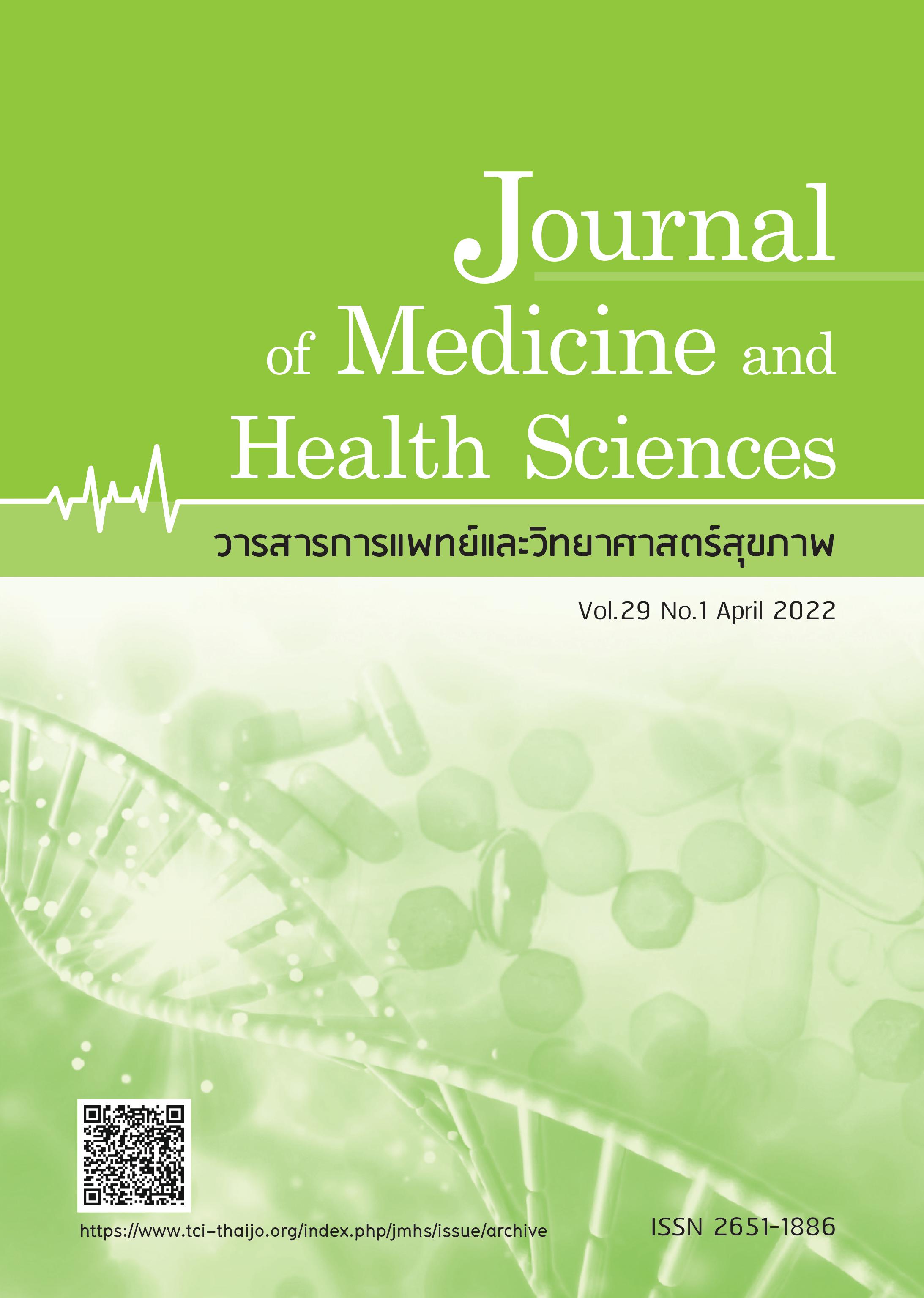The incidence of relapse tuberculosis and its determinants among Tuberculosis patients in Bangkok
Keywords:
incidence, risk factor, relapse, tuberculosis, BangkokAbstract
Abstract
Thailand was ranked as the 14th most tuberculosis-burdened country in the world. The
incidence rate of new tuberculosis (TB) cases in Thailand was approximately 1.3 times higher than global trends with an increasing trend of cases of drug-resistant TB. Based on the implementation of TB control in Thailand from 2002 to 2016, the average success rate for TB treatment was 78.87%. The main causes of unsuccessful TB treatment were a lack of medication, treatment failure and loss of follow-up. This unsuccessful TB treatment has resulted in an increase in the number of relapsed patients. In 2016, 2,514 relapsed cases were reported. There was also a greater recurrence of TB in densely populated and congested urban areas. This study aimed to estimate the incidence and identify the factors associated with cases of TB relapse in Bangkok. The data were collected from the databases of the National Tuberculosis Information Program from January 1, 2014 to November 31, 2018. The data were analyzed using the Kaplan–Meier method to estimate the incidence density and the multivariable Cox regression model was used to identify the factors associated with TB relapse and presented by hazard ratio (HR) with 95% confidence intervals (CIs). Of the 13,707 TB cases were included in this study, the mean age was 44.58 ± 16.91 years old and were predominantly male (60.81%). The incidence rate for relapse was 6.25 per 1,000 person-years (95% CIs= 5.48 - 7.13), and the median time for a TB relapse was 2.48 (interquartile range=0.16-4.91). In the multivariate analysis, TB relapse was independently associated with body weight at treatment initiation less than 50 kg (adjusted HR =1.46, 95% CI= 1.07-2.00), Diabetes mellitus (adjusted HR=3.01, 95% CI=1.83-4.96), and HIV infection (adjusted HR=2.12, 95% CI= 1.45-3.11). In conclusion, the screening for underweight TB patients (less than 50 kg) with co-morbidities may help to identify patients at a high risk of relapse. Therefore, the standard care and treatment of TB patients with these co-morbidities may need close monitoring to prevent and reduce the number of TB relapses.
References
World Health Organization. Global Tuberculosis Report 2020. 1, editor: WHO publications; 2020.
Tuberculosis Division. Tuberculosis situation in Thailand. Tuberculosis Division; 2020.
Tuberculosis Division by Epidemiology and emergency respond subdivision.Tuberculosis situation and sueveillance in Thailand. Tuberculosis Division, Department of Disease Control, Ministry of Public Health; 2020.
Jitdon J, Durongritichai V, Khungtumneam K. The Development of guidelines on homevisiting pulmonary tuberculosis patients with short course treatment in Mueang
district, Samut Prakan province. HCU Journal 2017;20.
Department of Medical Service, Tuberculosis Division, Department of Disease Control. Clinical Practice Guideline (CPG) of Tuberculosis Treatment in Adult 2018. Nontaburi Province: Department of Medical Service Ministry of Public Health; 2018.
Tuberculosis Division. Guidelines for programmatic management of drugresistant tuberculosis. Bangkok: Tuberculosis Division; 2015.
Shen X, Yang C, Wu J, et al. Recurrent tuberculosis in an urban area in China: Relapse or exogenous reinfection?.Tuberculosis (Edinb) 2017;103:97-104.
Gao L, Sun Y, Harley D, et al. Impact of multidrug resistance on tuberculosis
recurrence and long-term outcome in China. Plos One 2017;12.
Dobler CC, Crawford AB, Jelfs PJ, et al. Recurrence of tuberculosis in a lowincidence setting. Eur Respir J 2009;33: 160-7.
Lee P-H, Lin H-C, Huang AS-E, et al. Diabetes and risk of tuberculosis relapse: Nationwide Nested Case-Control Study. PLOS ONE 2014;9:e92623.
Golub JE, Durovni B, King BS, et al. Recurrent tuberculosis in HIV-infected patients in Rio de Janeiro, Brazil. AIDS 2008;22:2527-33.
Millet JP, Shaw E, Orcau A, et al. Tuberculosis recurrence after completion treatment in a European city: reinfection or relapse? PLoS One 2013;8:e64898.
Leung Chi C, Lam Tai H, Chan Wai M, et al. Lower Risk of Tuberculosis in Obesity. Arch Intern Med 2007;167:1297-340.
Dooley Kelly E, Lahlou O, Ghali L, et al. Risk factors for tuberculosis treatment failure, default, or relapse and outcomes of retreatment in Morocco. BMC Public Health 2011;11:2-7.
Franke MF, Appleton SC, Mitnick CD, et al. Aggressive regimens for multidrug-resistant tuberculosis reduce recurrence. Clin Infect Dis 2013;56:770-6.
Hung CL, Chien JY, Ou CY. Associated factors for tuberculosis recurrence in Taiwan: a nationwide nested case-control study from 1998 to 2010. PLoS One 2015; 10:e0124822.
André KM, Moise MV, Jackson KK, et al. Epidemiological profile of pulmonary tuberculosis relapse cases in the city of Butembo east of the democratic republic of Congo. JMR 2019;5:190-3.
Soares P, Duarte R, Gomes MGM, et al. Insights into tuberculosis: A survival analysis of time to recurrence in Portugal, between 2002 and 2009. Pulmonology 2020;26:318-20.
Cudahy PGT, Wilson D, Cohen T. Risk factors for recurrent tuberculosis after successful treatment in a high burden setting: a cohort study. BMC Infect Dis 2020;20:789.
World Health Organization. Global report on diabetes. France; 2016.
Gadoev J, Asadov D, Harries AD, et al. Recurrent tuberculosis and associated factors: A five - year countrywide study in Uzbekistan. PLoS One 2017;12:e0176473.
Unis G, Ribeiro AW, Esteves LS, et al. Tuberculosis recurrence in a high incidence setting for HIV and tuberculosis in Brazil. BMC Infectious Diseases. 2014;14:548.
Crofts JP, Andrews NJ, Barker RD, et al. Risk factors for recurrent tuberculosis in England and Wales, 1998-2005. Thorax 2010;65:310-4.
Millet J-P, Shaw E, Orcau À, et al. Tuberculosis recurrence after completion treatment in a european city: reinfection or relapse? PLoS One 2013;8:e64898.
Sonnenberg P, Murray J, Glynn JR, et al. HIV-1 and recurrence, relapse, and reinfection of tuberculosis after cure: a cohort study in South African mineworkers.Lancet 2001;358:1687-93.
Downloads
Published
How to Cite
Issue
Section
License

This work is licensed under a Creative Commons Attribution-NonCommercial-NoDerivatives 4.0 International License.



